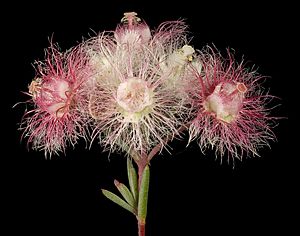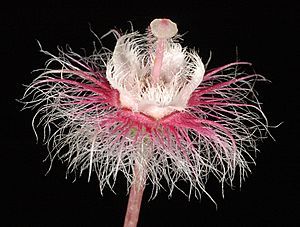Verticordia huegelii var. huegelii facts for kids
Quick facts for kids Verticordia huegelii var. huegelii |
|
|---|---|
 |
|
 |
|
| Scientific classification |
|
| Kingdom: | Plantae |
| Clade: | Tracheophytes |
| Clade: | Angiosperms |
| Clade: | Eudicots |
| Clade: | Rosids |
| Order: | Myrtales |
| Family: | Myrtaceae |
| Genus: | Verticordia |
| Species: | |
| Varietas: |
V. h. var. huegelii
|
| Trinomial name | |
| Verticordia huegelii var. huegelii |
|
The Verticordia huegelii var. huegelii, also known as the variegated featherflower, is a beautiful flowering plant. It belongs to the Myrtaceae family, which is the same family as myrtle trees. This plant grows naturally only in the south-west part of Western Australia. When a plant or animal is found only in one specific area, it is called endemic.
This featherflower is usually a tall, thin, or bushy shrub. Its flowers start as a creamy-white color. As they get older, they change to pink or a reddish-maroon. This color change makes the plant look like it has many different colors, which is why it's called "variegated." It looks a bit like another plant called Verticordia huegelii var. decumbens. However, our variegated featherflower grows straighter and does not have a special woody lump at its base called a lignotuber.
Contents
What Does the Variegated Featherflower Look Like?
Size and Shape of the Plant
The Verticordia huegelii var. huegelii is a shrub that usually grows to about 0.5 m (2 ft) tall. Some types of this plant, especially those found in the Darling Range, can grow taller, up to 0.9 m (3 ft) high. It can spread out to be about 10–45 cm (4–20 in) wide.
Leaves and Flowers
The leaves of this plant are long and thin, or sometimes shaped like a club. If you cut a leaf in half, it would look like a half-circle. They are usually about 2–8 mm (0.08–0.3 in) long.
The flowers do not have a smell. They grow in round groups near the ends of the branches. Each flower sits on a small stem that is about 4–11 mm (0.2–0.4 in) long. The part of the flower that holds the petals and sepals, called the floral cup, is shaped like a top. It is about 2–3 mm (0.08–0.1 in) long and can be smooth or a little bit hairy.
The sepals are like small leaves that protect the flower bud. They are creamy-white and turn pink or red as they age. They are about 5–6 mm (0.20–0.24 in) long and have many spreading hairs. The petals are similar in color to the sepals. They are mostly round and spread out, with a fringe of hairs around their edges. They are about 2–4 mm (0.08–0.2 in) long.
Inside the flower, there are special parts for reproduction. The staminodes are shaped like a spear or an egg and have a few hairs at their tip. The style is straight and about 5–5.5 mm (0.20–0.22 in) long. It has hairs around its top part and a cap-like tip called a stigma. This plant usually flowers from September to November.
Flower Color Variations
Some variegated featherflowers have flowers with a white style and a yellow stigma when they first open. Other types have a red stigma with red hairs. There is also a third type that has a pale yellow stigma.
Where Does the Variegated Featherflower Grow?
This type of Verticordia huegelii grows in different kinds of soil, including sand, clay, and loam. It often grows near rocks like granite, laterite, or sandstone. Sometimes, it can be found in areas that get wet during winter, but it also grows on hillsides. It often shares its home with other types of verticordia plants.
You can find this plant from near Geraldton in the north, all the way south to near Dwellingup. It also grows in some inland areas within the Avon Wheatbelt, Geraldton Sandplains, Jarrah Forest, and Swan Coastal Plain regions of Western Australia.
How to Grow Variegated Featherflower in Your Garden
If you plant the variegated featherflower in a garden, it usually grows as a single-stemmed, bushy shrub. It can reach a height of about 0.5 m (2 ft). Its beautiful variegated flowers can stay on the plant until December.
Most people grow this plant from cuttings, which means taking a small piece of the plant and helping it grow roots. It grows best when it gets lots of sunshine. This plant is usually quite strong and can grow well in different types of soil and weather, as long as the soil drains water away easily. It's important to keep the soil surface around the plant clear of dead leaves or other plant material. This helps prevent problems with fungal infections that can harm the plant.

